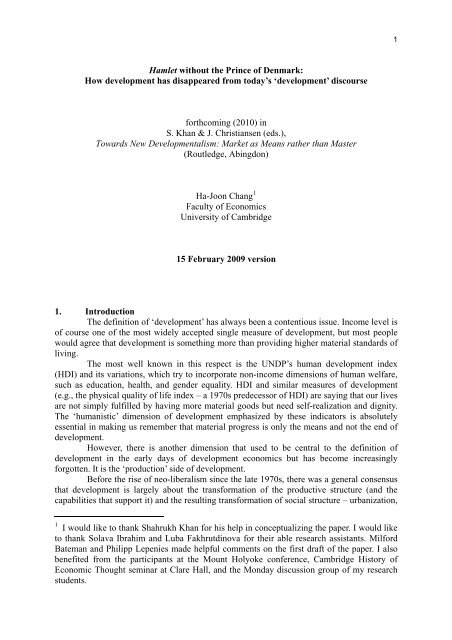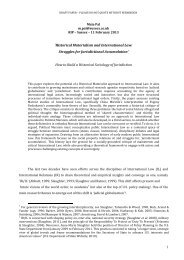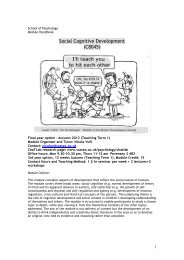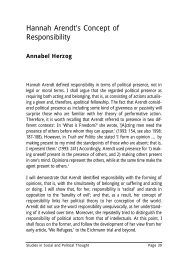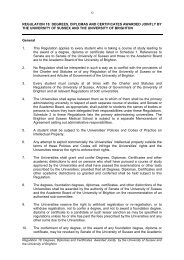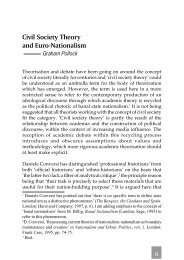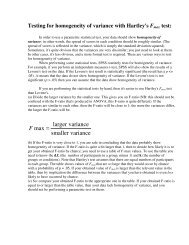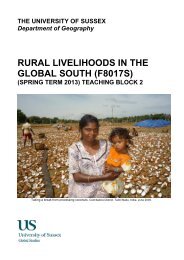Hamlet without the Prince of Denmark - University of Sussex
Hamlet without the Prince of Denmark - University of Sussex
Hamlet without the Prince of Denmark - University of Sussex
You also want an ePaper? Increase the reach of your titles
YUMPU automatically turns print PDFs into web optimized ePapers that Google loves.
<strong>Hamlet</strong> <strong>without</strong> <strong>the</strong> <strong>Prince</strong> <strong>of</strong> <strong>Denmark</strong>:<br />
How development has disappeared from today’s ‘development’ discourse<br />
forthcoming (2010) in<br />
S. Khan & J. Christiansen (eds.),<br />
Towards New Developmentalism: Market as Means ra<strong>the</strong>r than Master<br />
(Routledge, Abingdon)<br />
Ha-Joon Chang 1<br />
Faculty <strong>of</strong> Economics<br />
<strong>University</strong> <strong>of</strong> Cambridge<br />
15 February 2009 version<br />
1. Introduction<br />
The definition <strong>of</strong> ‘development’ has always been a contentious issue. Income level is<br />
<strong>of</strong> course one <strong>of</strong> <strong>the</strong> most widely accepted single measure <strong>of</strong> development, but most people<br />
would agree that development is something more than providing higher material standards <strong>of</strong><br />
living.<br />
The most well known in this respect is <strong>the</strong> UNDP’s human development index<br />
(HDI) and its variations, which try to incorporate non-income dimensions <strong>of</strong> human welfare,<br />
such as education, health, and gender equality. HDI and similar measures <strong>of</strong> development<br />
(e.g., <strong>the</strong> physical quality <strong>of</strong> life index – a 1970s predecessor <strong>of</strong> HDI) are saying that our lives<br />
are not simply fulfilled by having more material goods but need self-realization and dignity.<br />
The ‘humanistic’ dimension <strong>of</strong> development emphasized by <strong>the</strong>se indicators is absolutely<br />
essential in making us remember that material progress is only <strong>the</strong> means and not <strong>the</strong> end <strong>of</strong><br />
development.<br />
However, <strong>the</strong>re is ano<strong>the</strong>r dimension that used to be central to <strong>the</strong> definition <strong>of</strong><br />
development in <strong>the</strong> early days <strong>of</strong> development economics but has become increasingly<br />
forgotten. It is <strong>the</strong> ‘production’ side <strong>of</strong> development.<br />
Before <strong>the</strong> rise <strong>of</strong> neo-liberalism since <strong>the</strong> late 1970s, <strong>the</strong>re was a general consensus<br />
that development is largely about <strong>the</strong> transformation <strong>of</strong> <strong>the</strong> productive structure (and <strong>the</strong><br />
capabilities that support it) and <strong>the</strong> resulting transformation <strong>of</strong> social structure – urbanization,<br />
1 I would like to thank Shahrukh Khan for his help in conceptualizing <strong>the</strong> paper. I would like<br />
to thank Solava Ibrahim and Luba Fakhrutdinova for <strong>the</strong>ir able research assistants. Milford<br />
Bateman and Philipp Lepenies made helpful comments on <strong>the</strong> first draft <strong>of</strong> <strong>the</strong> paper. I also<br />
benefited from <strong>the</strong> participants at <strong>the</strong> Mount Holyoke conference, Cambridge History <strong>of</strong><br />
Economic Thought seminar at Clare Hall, and <strong>the</strong> Monday discussion group <strong>of</strong> my research<br />
students.<br />
1
dissolution <strong>of</strong> <strong>the</strong> traditional family, changes in gender relationships, rise <strong>of</strong> labour movement,<br />
<strong>the</strong> advent <strong>of</strong> <strong>the</strong> welfare state, and so on. This was mainly (although not exclusively) to be<br />
achieved through industrialization. Even though <strong>the</strong>y radically disagreed on how exactly this<br />
was to be done, most commentators – ranging from Walt Rostow on <strong>the</strong> right and <strong>the</strong><br />
Dependency Theorists on <strong>the</strong> left – shared <strong>the</strong> view that development is something centred<br />
around a process <strong>of</strong> transformation in <strong>the</strong> productive sphere.<br />
Most <strong>of</strong> us still hold such view <strong>of</strong> development at <strong>the</strong> instinctive level. For example,<br />
most people would not classify some oil-rich countries that have incomes higher than those <strong>of</strong><br />
some ‘developed’ countries as ‘developed’. In refusing to classify <strong>the</strong>se countries as<br />
‘developed’, we are implicitly saying that achieving high income through resource bonanza is<br />
not ‘development’ – <strong>the</strong> high income should be somehow ‘earned’. At <strong>the</strong> o<strong>the</strong>r extreme,<br />
following <strong>the</strong> Second World War, <strong>the</strong> German income level fell to that <strong>of</strong> Peru or Mexico, but<br />
few people would argue that Germany at that time should have been re-classified as a<br />
‘developing’ country, because we know that Germany still had <strong>the</strong> necessary technologies and<br />
organizational capabilities to regain its pre-war level <strong>of</strong> living standards quickly. 2 These<br />
examples show that we are implicitly saying that in order to qualify as ‘developed’ an<br />
economy’s high income should be based on superior knowledge, embodied in technologies<br />
and institutions, ra<strong>the</strong>r than simple command over resources.<br />
However, during <strong>the</strong> last quarter <strong>of</strong> a century, at <strong>the</strong> more formal level,<br />
‘development’ has come to mean something quite different from what it used to mean. As I<br />
shall show below, ‘development’ has come to mean poverty reduction, provision <strong>of</strong> basic<br />
needs, individual betterment, sustenance <strong>of</strong> existing productive structure – that is, anything<br />
but ‘development’ in <strong>the</strong> traditional sense. In o<strong>the</strong>r words, it has turned into <strong>Hamlet</strong> <strong>without</strong><br />
<strong>the</strong> <strong>Prince</strong> <strong>of</strong> <strong>Denmark</strong>!<br />
In this paper, I analyze <strong>the</strong> use <strong>of</strong> <strong>the</strong> term, ‘development’, in some <strong>of</strong> today’s key<br />
‘development’ discourses – <strong>the</strong> Millennium Development Goals <strong>of</strong> <strong>the</strong> United Nations, <strong>the</strong><br />
Doha Development Agenda (DDA) <strong>of</strong> <strong>the</strong> WTO (World Trade Organization), and <strong>the</strong><br />
discourse on micro-finance. I will argue that <strong>the</strong>se discourses have a view <strong>of</strong> ‘development’<br />
that lacks a vision <strong>of</strong> transformation in productive structure (and <strong>the</strong> development <strong>of</strong> social<br />
and technological capabilities that are both <strong>the</strong> causes and <strong>the</strong> consequences <strong>of</strong> such<br />
transformation). They are, consequently, unable to promote development, and can even be<br />
anti-developmental. At most, today’s mainstream view <strong>of</strong> development is that <strong>of</strong> an ersatz<br />
development, which relies upon uncoordinated individual initiatives. I will conclude <strong>the</strong><br />
paper by arguing that a discourse on ‘new developmentalism’ should be constructed by<br />
reviving <strong>the</strong> ‘productionist’ concern <strong>of</strong> <strong>the</strong> old development economics, while paying greater<br />
attention to <strong>the</strong> issues <strong>of</strong> human development, politics, technological development,<br />
institutions, and <strong>the</strong> environment than was <strong>the</strong> case in <strong>the</strong> old days.<br />
2. Development <strong>without</strong> development: <strong>the</strong> MDGs<br />
Since <strong>the</strong> rise <strong>of</strong> neo-liberalism in <strong>the</strong> late 1970s and <strong>the</strong> early 1980s, many people in<br />
<strong>the</strong> rich countries, both inside and outside <strong>the</strong> academia, have come to take <strong>the</strong> view that <strong>the</strong><br />
2 In 1946, Germany’s per capita income in PPP terms was $2,217 – a huge fall from <strong>the</strong><br />
wartime peak <strong>of</strong> $6,084 in 1944. In <strong>the</strong> same year, per capita income in Peru was $2,046 and<br />
that in Mexico was $2,211. Ten years later, in 1956, German per capita income surpassed <strong>the</strong><br />
wartime peak <strong>of</strong> $6,177, but <strong>the</strong> Peruvian and <strong>the</strong> Mexican per capita income remained at<br />
$2,731 and $2,843. The data for Germany are from Table 1c and that for <strong>the</strong> Latin American<br />
countries are from Table 4c <strong>of</strong> Maddison (2003).<br />
2
developing countries are what <strong>the</strong>y are only because <strong>of</strong> <strong>the</strong>ir own inabilities and corruption<br />
and that <strong>the</strong> rich countries have no moral obligations to help <strong>the</strong>m. Indeed, <strong>the</strong>re is a growing<br />
view that helping <strong>the</strong> developing countries is actually bad for <strong>the</strong>m because it will only<br />
encourage dependency mentality.<br />
Fortunately, <strong>the</strong> above view is not <strong>the</strong> mainstream view in all rich countries. Most<br />
people still believe that, with a strong help from <strong>the</strong> rich countries, <strong>the</strong> developing countries<br />
can pull <strong>the</strong>mselves out <strong>of</strong> poverty. The most ‘progressive’ and comprehensive <strong>of</strong> <strong>the</strong><br />
mainstream discourses on development along this line is arguably embodied in <strong>the</strong> United<br />
Nation’s Millennium Development Goals (MDGs).<br />
According to <strong>the</strong> UN, <strong>the</strong> MDGs’ eight goals are:<br />
Goal 1: Eradicate extreme poverty and hunger.<br />
Goal 2: Achieve universal primary education.<br />
Goal 3: Promote gender equality and empower women.<br />
Goal 4: Reduce child mortality.<br />
Goal 5: Improve maternal health.<br />
Goal 6: Combat HIV/AIDS, malaria, and o<strong>the</strong>r diseases.<br />
Goal 7: Ensure environmental sustainability.<br />
Goal 8: Develop a global partnership for development.<br />
There are many different elements in <strong>the</strong> MDGs, especially as each goal has a<br />
number <strong>of</strong> ‘targets’ that span across different sub-issues, but most <strong>of</strong> <strong>the</strong>m relate to reducing<br />
poverty and improving education and health in poor countries. This is obvious for <strong>the</strong> case <strong>of</strong><br />
goals 1-6, but telling from <strong>the</strong> targets under its heading, even goal 7 (environmental<br />
sustainability) is partly about health (improving access to safe drinking water and increasing<br />
access to improved sanitation). 3<br />
Laudable <strong>the</strong>se goals and targets may be, <strong>the</strong>ir sum total does not amount to<br />
development in <strong>the</strong> sense we are talking about, as <strong>the</strong>y pay no serious attention to <strong>the</strong><br />
transformation <strong>of</strong> productive structure and capabilities.<br />
The only explicit ‘development’ dimension in <strong>the</strong> MDGs is embodied in Goal 8. The<br />
targets under this heading include: development <strong>of</strong> an ‘open, rule-based, predictable, nondiscriminatory<br />
trading system’; reduction or even writing-<strong>of</strong>f <strong>of</strong> developing country foreign<br />
debt; increase in foreign aid from rich countries, including trade-related technical assistance;<br />
provision <strong>of</strong> access to affordable essential drugs for developing countries; and <strong>the</strong> spread <strong>of</strong><br />
new technologies, mainly information and communications technologies.<br />
The emphasis in this vision is very much on <strong>the</strong> trinity <strong>of</strong> increased aid, debt<br />
reduction, and increased trade. Debt reduction and increased aid (unless <strong>the</strong>y are on very<br />
large scales, which <strong>the</strong>y are not going to be) are simply enabling conditions (and in which <strong>the</strong><br />
developing countries are mere recipients ra<strong>the</strong>r than originators), ra<strong>the</strong>r than those that<br />
determine <strong>the</strong> contents <strong>of</strong> development. Thus seen, <strong>the</strong> view on <strong>the</strong> relationship between trade<br />
and development is <strong>the</strong> key to understanding <strong>the</strong> vision <strong>of</strong> development underlying <strong>the</strong> MDGs.<br />
So what are <strong>the</strong> contents <strong>of</strong> an ‘open, rule-based, predictable, non-discriminatory trading<br />
system’ that <strong>the</strong> MDG agenda talks about here?<br />
Telling from <strong>the</strong> concrete indicators that measure <strong>the</strong> ‘developmental’ contribution <strong>of</strong><br />
<strong>the</strong> world trading system in <strong>the</strong> MDG discourse, we see that <strong>the</strong> ‘pro-developmental’ trading<br />
system boils down to one where <strong>the</strong> rich countries reduce <strong>the</strong>ir tariffs and subsidies on<br />
3 Detailed targets under each goal <strong>of</strong> <strong>the</strong> MDGs can be found at <strong>the</strong> United Nations website<br />
and Reddy & Heuty (2006), Appendix 1.<br />
3
agriculture, textile, and clothing exports from developing countries, especially <strong>the</strong> least<br />
developed countries (LDCs).<br />
However, <strong>the</strong> understanding <strong>of</strong> <strong>the</strong> relationship between trade and development<br />
implicit in this vision is non-developmental. In this vision, <strong>the</strong> best way to make trade help<br />
development is by liberalizing <strong>the</strong> rich country markets so that <strong>the</strong> developing countries can<br />
sell more <strong>of</strong> what <strong>the</strong>y are already selling – or ‘trade <strong>the</strong>ir way out <strong>of</strong> poverty’, as a popular<br />
slogan puts it. There is no notion that developing countries need to get out <strong>of</strong> what <strong>the</strong>y are<br />
doing now (<strong>the</strong> specialization in which is after all what keeps <strong>the</strong>m poor) and move into<br />
higher-productivity activities, if <strong>the</strong>y are to achieve development. 4<br />
Thus seen, <strong>the</strong> MDG envisages ‘development <strong>without</strong> development’. Most <strong>of</strong> what it<br />
takes as ‘development’ is really provision <strong>of</strong> basic needs and poverty reduction. What little<br />
attention it pays to <strong>the</strong> question <strong>of</strong> production is based on <strong>the</strong> view that development can be<br />
achieved by specializing more in <strong>the</strong> products in which a country has comparative advantage<br />
(supported by <strong>the</strong> rich countries reducing debts and giving more aids).<br />
However, doing more <strong>of</strong> <strong>the</strong> same thing in terms <strong>of</strong> one’s productive activities is not<br />
how today’s developed countries have become developed. Starting from 18 th century Britain<br />
through to 19 th century USA, Germany, and Sweden, down to 20 th century Japan, Korea, and<br />
Taiwan, history has repeatedly shown that development is achieved by upgrading a country’s<br />
productive capabilities and moving into more ‘difficult’ industries before <strong>the</strong>y acquire<br />
comparative advantages in those new activities, by using protection, subsidies, and o<strong>the</strong>r<br />
means <strong>of</strong> market-defying government intervention (Chang, 2002a, 2007a). Let me give some<br />
prominent examples.<br />
In 1960, when Nokia entered <strong>the</strong> electronics industry, per capita income <strong>of</strong> Finland<br />
was only 41% that <strong>of</strong> <strong>the</strong> US, <strong>the</strong> frontier country in electronics and overall ($1,172 vs.<br />
$2,881). It was thus not a big surprise that <strong>the</strong> electronics subsidiary <strong>of</strong> Nokia ran losses for<br />
17 years and remained in business mainly because <strong>of</strong> cross-subsidization from mature firms<br />
in <strong>the</strong> same business group (helped by government procurement programmes).<br />
In 1961, per capita income <strong>of</strong> Japan was a mere 19% that <strong>of</strong> <strong>the</strong> US ($563 vs. $2,934),<br />
but Japan was <strong>the</strong>n protecting and promoting all sorts <strong>of</strong> ‘wrong’ industries through high<br />
tariffs, government subsidies, and ban on foreign direct investment – automobile, steel,<br />
shipbuilding, and so on.<br />
To take an even more dramatic example, take <strong>the</strong> case <strong>of</strong> South Korea. Its (<strong>the</strong>n)<br />
state-owned steel mill, POSCO, which had been set up in 1968, started production in 1972,<br />
when its per capita income was a mere 5.5% <strong>of</strong> <strong>the</strong> US income ($322 vs. $5,838). 5 To make it<br />
worse, in <strong>the</strong> same year, South Korea decided to deviate even fur<strong>the</strong>r from its comparative<br />
advantage by launching its ambitious Heavy and Chemical Industrialization programme,<br />
which promoted shipbuilding, (home-designed) automobile, machinery, and many o<strong>the</strong>r<br />
‘wrong’ industries. Even as late as 1983, when Samsung decided to design its own semiconductors,<br />
Korea’s income was only 14% that <strong>of</strong> <strong>the</strong> US ($2,118 vs. $15,008).<br />
By discussing <strong>the</strong>se examples <strong>of</strong> countries defying <strong>the</strong> market and entering activities<br />
where <strong>the</strong>y do not have comparative advantage, I do not mean that all forms <strong>of</strong> ‘traditional’<br />
activities, such as agriculture or textile/clothing, are incompatible with development. After all,<br />
4 Moreover, it is not as if <strong>the</strong> reduction in tariffs/subsidies for agriculture and textile/clothing<br />
is going to help <strong>the</strong> developing countries very much. As I will show in <strong>the</strong> next section when<br />
I discuss <strong>the</strong> DDA, <strong>the</strong> benefits <strong>of</strong> <strong>the</strong>se reductions are going to be quite modest and<br />
concentrated among <strong>the</strong> rich farmers in some <strong>of</strong> <strong>the</strong> richer developing countries, such as<br />
Brazil and Argentina.<br />
5 Even in PPP terms, its income was only 16% that <strong>of</strong> <strong>the</strong> US ($2,561 vs. $15,944).<br />
4
<strong>the</strong> Ne<strong>the</strong>rlands is still <strong>the</strong> world’s third largest exporter <strong>of</strong> agriculture despite not having<br />
much land (it has <strong>the</strong> fifth highest population density in <strong>the</strong> world, excluding city states or<br />
island states with territories less than, and including, that <strong>of</strong> Hong Kong). 6 For ano<strong>the</strong>r<br />
example, Germany used to be <strong>the</strong> world’s fifth largest exporter <strong>of</strong> textiles and clothing until<br />
as late as <strong>the</strong> early 1990s. However, <strong>the</strong>se were possible only because <strong>the</strong>se countries applied<br />
advanced technologies to <strong>the</strong>se ‘traditional’ activities and upgraded <strong>the</strong>m – hydroponic<br />
culture in <strong>the</strong> case <strong>of</strong> Dutch agriculture and specialty textiles and high-class design in <strong>the</strong> case<br />
<strong>of</strong> German textile/clothing. At <strong>the</strong> o<strong>the</strong>r extreme, countries like <strong>the</strong> Philippines export a lot <strong>of</strong><br />
high-tech products, like electronics, but no one calls it developed because <strong>the</strong> production uses<br />
someone else’s technologies, is organized by someone else, and has few roots in <strong>the</strong> domestic<br />
economy. Should all <strong>the</strong> multinational companies decide to leave <strong>the</strong> Philippines tomorrow, it<br />
will be reduced to exporting primary commodities.<br />
Once again, <strong>the</strong>se examples confirm my earlier point that it is not what one has but<br />
how one has got it that determines whe<strong>the</strong>r a country is developed or not. Without any vision<br />
<strong>of</strong> transformation in productive structure and <strong>the</strong> upgrading <strong>of</strong> <strong>the</strong> productive capabilities that<br />
make it possible, <strong>the</strong> vision <strong>of</strong> development behind <strong>the</strong> MDGs can only be described as<br />
‘development <strong>without</strong> development’.<br />
3. Anti-developmental development agenda: <strong>the</strong> DDA<br />
The ‘non-developmental’ nature <strong>of</strong> <strong>the</strong> MDGs is bad enough. However, <strong>the</strong><br />
‘development’ discourse becomes positively anti-developmental when it comes to <strong>the</strong> Doha<br />
‘Development’ Agenda (DDA) <strong>of</strong> <strong>the</strong> WTO talks.<br />
Launched in November 2001 in <strong>the</strong> Doha ministerial talks <strong>of</strong> <strong>the</strong> WTO, <strong>the</strong> DDA<br />
claims to give a special attention to <strong>the</strong> needs <strong>of</strong> <strong>the</strong> developing countries, compared to<br />
previous rounds <strong>of</strong> trade talks. There are many different elements in this agenda, which<br />
comprises 21 areas including everything from agricultural subsidies to e-commerce. However,<br />
<strong>the</strong> core <strong>of</strong> <strong>the</strong> DDA is what we can describe as <strong>the</strong> ‘agriculture-industry swap’ between <strong>the</strong><br />
developed countries and <strong>the</strong> developing countries – basically <strong>the</strong> former countries lowering<br />
<strong>the</strong>ir agricultural tariffs and subsidies, in return for <strong>the</strong> latter lowering <strong>the</strong>ir industrial<br />
protection under <strong>the</strong> so-called non-agricultural market access (NAMA) negotiations.<br />
Although <strong>the</strong> negotiations are stalled at <strong>the</strong> moment (and it could collapse, given <strong>the</strong><br />
current global economic crisis), it is mainly because <strong>of</strong> <strong>the</strong> magnitudes <strong>of</strong> <strong>the</strong> cuts on both<br />
sides. Even as <strong>the</strong>y disagree on who should cut <strong>the</strong>ir tariffs and subsidies in which areas by<br />
how much, most people seem to accept <strong>the</strong> principle behind <strong>the</strong> agenda itself – that <strong>the</strong><br />
developed countries should specialize in industry and <strong>the</strong> developing countries should<br />
specialize in agriculture and <strong>the</strong>refore that whatever is making that specialization difficult<br />
should be criticized.<br />
The first trouble with this vision is that <strong>the</strong> agriculture-industry swap is not going to<br />
help ‘development’ very much even in <strong>the</strong> anodyne MDG sense. In reality, many developing<br />
countries are net agricultural importers and thus unlikely to benefit from agricultural<br />
liberalization in <strong>the</strong> developed countries. They may even get hurt as a result <strong>of</strong> agricultural<br />
liberalization in <strong>the</strong> developed countries, if <strong>the</strong>y happen to be importers <strong>of</strong> those agricultural<br />
products that are heavily subsidized by <strong>the</strong> developed countries. This could directly hit MDG<br />
goals regarding hunger and health.<br />
Overall, <strong>the</strong> main beneficiaries <strong>of</strong> <strong>the</strong> opening up <strong>of</strong> agricultural markets in <strong>the</strong><br />
6 Only Bangladesh (1,045 persons per km 2 ), Taiwan (636 persons per km 2 ), Mauritius (610<br />
persons per km 2 ) and South Korea (498 persons per km 2 ) have higher population densities.<br />
5
developed world will be o<strong>the</strong>r developed countries with strong agriculture – <strong>the</strong> USA, Canada,<br />
Australia, and New Zealand. 7 Most developing countries export agricultural products that are<br />
not protected very much by <strong>the</strong> developed countries for <strong>the</strong> simple reason that <strong>the</strong>y do not<br />
have any domestic producers (e.g., c<strong>of</strong>fee, cocoa). Only two developing countries, Brazil and<br />
Argentina, which are major exporters <strong>of</strong> those ‘temperate’ products where developed country<br />
tariffs and subsidies are concentrated (e.g., beef, wheat), are likely to benefit from this in a<br />
major way. Moreover, some (although obviously not all) <strong>of</strong> <strong>the</strong> prospective losers from<br />
agricultural trade liberalization within <strong>the</strong> developed countries will be <strong>the</strong> least well-<strong>of</strong>f<br />
people by <strong>the</strong>ir national standards (e.g., hard-pressed farmers in Norway, Japan, or<br />
Switzerland), while some <strong>of</strong> <strong>the</strong> prospective beneficiaries in developing countries are rich<br />
even by international standards (e.g., agricultural capitalists in Brazil or Argentina). In this<br />
sense, <strong>the</strong> popular image that agricultural liberalization in <strong>the</strong> developed countries as mainly<br />
helping poor peasant farmers in developing countries is totally misleading. 8<br />
More importantly, in <strong>the</strong> long run, <strong>the</strong> DDA is likely to hinder, ra<strong>the</strong>r than help,<br />
development, by making it structurally very difficult for <strong>the</strong> developing countries to<br />
transform <strong>the</strong>ir productive capabilities. This is because, in return for liberalization in<br />
agriculture and textile/clothing by <strong>the</strong> developed countries, developing countries are<br />
demanded to reduce <strong>the</strong>ir industrial tariffs (which incidentally shows that <strong>the</strong> developed<br />
countries do not really believe in free trade <strong>the</strong>ory, which argues that trade liberalization does<br />
not require any compensation – unilateral trade liberalization is always beneficial, whatever<br />
one’s trading partner does).<br />
Of course, reduction in industrial tariffs may bring some benefits to <strong>the</strong> consumers <strong>of</strong><br />
<strong>the</strong> developing countries, but <strong>the</strong>se gains are unlikely to be more than (an one-<strong>of</strong>f gain <strong>of</strong>)<br />
1.5% <strong>of</strong> developing country income even according to <strong>the</strong> optimistic scenarios envisaged by<br />
<strong>the</strong> World Bank (Chang, 2005, p. 28). Moreover, <strong>the</strong>se short-term gains are likely to be<br />
quickly overwhelmed by <strong>the</strong> long-term losses that come from <strong>the</strong> inability (due to tariff cuts)<br />
on <strong>the</strong> part <strong>of</strong> <strong>the</strong> developing countries to promote ‘infant’ industries. In addition to <strong>the</strong><br />
historical evidence, which I have discussed in <strong>the</strong> previous section, <strong>the</strong>re are many<br />
respectable economic <strong>the</strong>ories that show that a transformation in <strong>the</strong> productive structure <strong>of</strong> a<br />
developing country is highly unlikely <strong>without</strong> some sort <strong>of</strong> ‘infant’ industry protection (and<br />
o<strong>the</strong>r supportive policies) (Chang, 2005).<br />
The potential long-run damages to development prospect from <strong>the</strong> NAMA<br />
negotiations are great, as <strong>the</strong> cuts in industrial tariffs <strong>of</strong> <strong>the</strong> developing countries proposed by<br />
<strong>the</strong> developed countries in <strong>the</strong> NAMA negotiations are on historically unprecedented scales.<br />
Even though <strong>the</strong> US proposal to abolish all industrial tariffs by 2015 is considered to be a<br />
deliberately radical opening gambit, <strong>the</strong> core US proposal is to bring average industrial tariffs<br />
in developing countries down to 5-7% by 2010, <strong>the</strong> lowest level since <strong>the</strong> days <strong>of</strong> colonialism<br />
and unequal treaties when <strong>the</strong> weaker countries were deprived <strong>of</strong> policy autonomy, especially<br />
7 See Stiglitz & Charlton (2005), pp. 121-2 and Appendix 1. For various numerical estimates<br />
<strong>of</strong> <strong>the</strong> gains from agricultural liberalization in <strong>the</strong> rich countries, see Ackerman (2005). Two<br />
World Bank estimates cited by Ackerman put <strong>the</strong> share <strong>of</strong> <strong>the</strong> developed countries in <strong>the</strong> total<br />
world gain from trade liberalization in agriculture by high-income countries at 75% ($41.6<br />
billon out <strong>of</strong> $55.7 billion) and 70% ($126 billion out <strong>of</strong> $182 billion).<br />
8 The o<strong>the</strong>r main beneficiaries <strong>of</strong> agricultural liberalization in rich countries, that is, <strong>the</strong>ir<br />
consumers, do not gain very much. As a proportion <strong>of</strong> income, <strong>the</strong>ir spending on agricultural<br />
products is already pretty low (around 13% for food and 4% for alcohol and tobacco, <strong>of</strong><br />
which only a fraction is <strong>the</strong> cost <strong>of</strong> <strong>the</strong> agricultural produce itself). Moreover, <strong>the</strong> trade in<br />
many agricultural products <strong>the</strong>y buy is already liberalized (e.g., c<strong>of</strong>fee, tea, cocoa).<br />
6
<strong>the</strong> right to set tariffs (on colonialism and unequal treaties, see Chang, 2002a, pp. 51-4). 9<br />
With very few exceptions, <strong>the</strong>y will be also lower than <strong>the</strong> rates that had prevailed in today’s<br />
developed countries until <strong>the</strong> early 1970s (see Chang, 2005, for fur<strong>the</strong>r details). 10<br />
Moreover, <strong>the</strong> context in which <strong>the</strong> industrial tariff cuts are to be made magnifies <strong>the</strong>ir<br />
potential negative impacts. The range <strong>of</strong> policy tools available to <strong>the</strong> developing countries has<br />
shrunk sharply in <strong>the</strong> last two decades. During this period, through <strong>the</strong> WTO and various<br />
bilateral and regional FTAs (free-trade agreements), subsidies, quantitative restrictions,<br />
foreign investment regulations (such as local contents requirements), directed credit<br />
programmes, foreign exchange rationing, and many o<strong>the</strong>r tools <strong>of</strong> industrial promotion have<br />
become ei<strong>the</strong>r impossible to use or very circumscribed. Given this shrinkage in policy space<br />
in o<strong>the</strong>r areas, <strong>the</strong> relative importance <strong>of</strong> tariffs as a policy tool has, unintendedly, increased<br />
significantly in <strong>the</strong> recent period (on <strong>the</strong> question <strong>of</strong> policy space, see Chang, 2005, and<br />
Gallagher (ed.), 2005). If <strong>the</strong>y have <strong>the</strong>ir abilities to use tariffs curtailed significantly, <strong>the</strong>re<br />
will be few o<strong>the</strong>r policy tools that <strong>the</strong> developing countries can use to engineer <strong>the</strong><br />
transformation <strong>of</strong> <strong>the</strong>ir productive structure and capabilities.<br />
To make it even worse, <strong>the</strong> tariff cuts are to be made in a manner that is much more<br />
stringent than before. For example, in <strong>the</strong> Uruguay Round, tariff cuts involved only cuts in<br />
(trade-weighted) average tariffs. This time, a “Swiss” formula, which requires that higher<br />
tariffs be cut most steeply and that tariffs are cut line-by-line, is to be employed. This means<br />
that <strong>the</strong> developing countries are not even going to have <strong>the</strong> freedom to protect some key<br />
sectors while cutting tariffs in o<strong>the</strong>rs. In contrast, in agriculture, where <strong>the</strong>y are largely on <strong>the</strong><br />
defensive, <strong>the</strong> developed countries advocate a much less draconian tariff reduction formula<br />
and are refusing to put caps on agricultural tariffs.<br />
Thus seen, <strong>the</strong> DDA deal is not simply non-developmental (like <strong>the</strong> MDGs) but it is<br />
deeply anti-developmental in <strong>the</strong> sense that it not only encourages developing countries to<br />
stick to <strong>the</strong>ir current production structure but also makes it impossible for <strong>the</strong>m to move away<br />
from it in <strong>the</strong> future. 11<br />
4. Ersatz Developmentalism: <strong>the</strong> MDGs and Micro-finance<br />
Having shown how <strong>the</strong> currently dominant development vision fails to see<br />
development as a process <strong>of</strong> transformation <strong>of</strong> a country’s productive structure and<br />
capabilities, it would be unfair to suggest that <strong>the</strong>re is no attempt whatsoever to increase<br />
productive capabilities in that vision. After all, improvements in health and education<br />
emphasized by <strong>the</strong> MDGs should increase <strong>the</strong> productive capabilities <strong>of</strong> individuals,<br />
especially <strong>the</strong> poor.<br />
However, today’s mainstream development discourse sees <strong>the</strong>se increases in<br />
productive capabilities as happening mainly through individual betterment. For example, six<br />
9 The EC proposal will bring average industrial tariffs down to 5-15%.<br />
10 The exceptions are Britain and <strong>the</strong> Ne<strong>the</strong>rlands between <strong>the</strong> late-19 th and <strong>the</strong> early 20 th<br />
centuries, Germany briefly in <strong>the</strong> late 19 th century, and <strong>Denmark</strong> after <strong>the</strong> Second World War.<br />
11 Supplementary to <strong>the</strong> MDGs and <strong>the</strong> DDA is <strong>the</strong> ‘aid for trade’ deal, supported, among<br />
o<strong>the</strong>rs, by <strong>the</strong> WTO. In this deal, developing countries are asked to liberalize <strong>the</strong>ir trade in<br />
return for <strong>the</strong> additional foreign aid that will enable <strong>the</strong>m to make extra investment in skills<br />
and infrastructure. However, trade liberalization will destroy, and make it very difficult to<br />
newly set up in <strong>the</strong> future, <strong>the</strong> very locales <strong>of</strong> accumulation <strong>of</strong> productive capabilities, namely,<br />
productive enterprises in high-productivity industries.<br />
7
<strong>of</strong> eight MDGs are about improving income, health, and education <strong>of</strong> individuals (with <strong>the</strong><br />
partial exception <strong>of</strong> Goal 3, namely, gender equality and female empowerment, <strong>the</strong> latter <strong>of</strong><br />
which by definition is a ‘relational’ thing). There is relatively little discussion <strong>of</strong> <strong>the</strong> need to<br />
improve social institutions, except in <strong>the</strong> highly problematic assertion that developing<br />
countries should be encouraged, or even required, to adopt ‘global standard’ institutions (for a<br />
critique <strong>of</strong> <strong>the</strong> global standards discourse, see Chang, 2007b and 2007c). Ano<strong>the</strong>r important<br />
example is micro-finance, which, according to today’s orthodoxy, is supposed to promote<br />
development by helping people lift <strong>the</strong>mselves out <strong>of</strong> poverty through <strong>the</strong>ir own<br />
entrepreneurial efforts (for a ‘productionist’ critique <strong>of</strong> micr<strong>of</strong>inance, see Bateman & Chang,<br />
2009). Even <strong>the</strong> mainstream discourse on institutions very much emphasize <strong>the</strong> protection <strong>of</strong><br />
private property rights, partly because it is seen as crucial in inducing rational self-seeking<br />
individuals into entrepreneurial activities (see Chang, 2007b).<br />
At one level, <strong>the</strong>re is nothing wrong with all this. Entrepreneurship is an important,<br />
albeit not <strong>the</strong> only, force behind <strong>the</strong> increase in a country’s productive capability. When <strong>the</strong><br />
capabilities <strong>of</strong> individuals in a country – whe<strong>the</strong>r in terms <strong>of</strong> education, health, or ability to<br />
acquire credit (as in micr<strong>of</strong>inance) – are enhanced, <strong>the</strong> country’s productive capabilities are<br />
likely to increase.<br />
However, <strong>the</strong>re are only so many productive capabilities that can be developed<br />
through improvements at <strong>the</strong> individual level. This is because development in productive<br />
capabilities in reality mainly occurs in (public, private, and co-operative) productive<br />
enterprises. However well-educated and healthy <strong>the</strong> individuals may be, <strong>the</strong>y cannot produce<br />
rapid, lasting, and sustainable productivity growth that makes development possible, unless<br />
<strong>the</strong>y are employed by firms engaged in production activities with large scopes <strong>of</strong> productivity<br />
increase.<br />
Even if <strong>the</strong> total number and <strong>the</strong> capabilities <strong>of</strong> <strong>the</strong> individuals involved are <strong>the</strong> same,<br />
more and better ideas will be produced by individuals working toge<strong>the</strong>r in a productive<br />
enterprise through cross-fertilization <strong>of</strong> ideas than isolated individuals running <strong>the</strong>ir own oneman<br />
operations. Moreover, because much <strong>of</strong> <strong>the</strong> knowledge in productive enterprises is<br />
acquired in a ‘collective’ manner in <strong>the</strong> sense that <strong>the</strong>y are created in <strong>the</strong> context <strong>of</strong> a complex<br />
division <strong>of</strong> labour (ra<strong>the</strong>r than through <strong>the</strong> activities <strong>of</strong> isolated individuals) and deposited in<br />
<strong>the</strong> form <strong>of</strong> organizational routines and institutional memories (ra<strong>the</strong>r than in individuals),<br />
when <strong>the</strong> individuals are organized into productive enterprises, productivity growth stops<br />
being dependent on individuals and <strong>the</strong>refore acquires a self-sustaining dynamic that<br />
individual entrepreneurship cannot produce.<br />
To put it more graphically, 1,000 extra street food stalls or 1,000 one-man TV repair<br />
shops are not going to enhance national productive capabilities in <strong>the</strong> same way that one<br />
modern supermarket or one electronics manufacturer employing 600 workers and getting<br />
supplied by 20 small enterprises that employ 20 people each on average. Even if those 1,000<br />
owners <strong>of</strong> <strong>the</strong> food stalls or TV repair shops all have PhDs in food technology or electronics<br />
and even if most <strong>of</strong> <strong>the</strong> 1,000 employees working in (large and small) modern enterprises<br />
have only primary education, <strong>the</strong> former are still unlikely to enhance <strong>the</strong> country’s productive<br />
capabilities as much as <strong>the</strong> latter can.<br />
Thus seen, <strong>the</strong> emphasis on individual capabilities and entrepreneurial energy that<br />
dominates today’s mainstream development discourse is largely misplaced. To put my<br />
argument above somewhat differently, what really distinguish <strong>the</strong> US or Germany, on <strong>the</strong> one<br />
hand, and <strong>the</strong> Philippines or Nigeria, on <strong>the</strong> o<strong>the</strong>r hand, are <strong>the</strong>ir Boeings and Volkswagens,<br />
and not <strong>the</strong>ir economists or medical doctors (which <strong>the</strong> latter countries have in quite large<br />
quantities). Similarly, what really distinguishes Ecuador or Vietnam from <strong>the</strong> US or Japan is<br />
not <strong>the</strong> raw entrepreneurial energy <strong>of</strong> <strong>the</strong> people that <strong>the</strong> neo-liberals so <strong>of</strong>ten talk about<br />
8
(which you probably have more in <strong>the</strong> former group <strong>of</strong> countries) but <strong>the</strong> abilities <strong>of</strong> a society<br />
to set up and manage productive enterprises that can channel that individual energy into<br />
raising productivity.<br />
What little developmentalism that <strong>the</strong>re is in <strong>the</strong> currently dominant vision <strong>of</strong><br />
development is ersatz developmentalism – <strong>the</strong> belief that, if you educate <strong>the</strong>m better and<br />
make <strong>the</strong>m healthier and give <strong>the</strong>m security <strong>of</strong> property rights, rational self-seeking<br />
individuals will exercise <strong>the</strong>ir natural tendency to ‘truck and barter’ and somehow create a<br />
prosperous economy. However, this vision is fundamentally at odds with <strong>the</strong> reality <strong>of</strong><br />
development. In reality, development requires a lot <strong>of</strong> collective and systematic efforts at<br />
acquiring and accumulating better productive knowledge through <strong>the</strong> construction <strong>of</strong> better<br />
organizations, <strong>the</strong> cross-fertilization <strong>of</strong> ideas within it, and <strong>the</strong> channeling <strong>of</strong> individual<br />
entrepreneurial energy into collective entrepreneurship.<br />
5. Concluding Remarks: Towards a New Developmentalism<br />
This paper has argued that <strong>the</strong> currently dominant discourse on ‘development’ really<br />
lacks any real notion <strong>of</strong> development in <strong>the</strong> sense <strong>of</strong> <strong>the</strong> transformation <strong>of</strong> productive<br />
capabilities and structure (and <strong>the</strong> accompanying social changes). In line with <strong>the</strong><br />
comparative advantage argument, it emphasizes <strong>the</strong> need for developing countries to stick to<br />
<strong>the</strong>ir existing specializations in agriculture and textile/clothing. It is suggested that this should<br />
be encouraged by <strong>the</strong> lowering <strong>of</strong> trade barriers in rich countries vis-à-vis products in which<br />
poor countries have comparative advantage, such as agricultural products and textile/clothing.<br />
Sometimes, as in <strong>the</strong> DDA, <strong>the</strong> discourse can even be positively anti-developmental, when it<br />
is demanded that developing countries give up <strong>the</strong>ir industrial tariffs in return for <strong>the</strong> rich<br />
countries lowering <strong>the</strong>ir trade barriers in agriculture. In so far as <strong>the</strong>re is some minimal<br />
awareness <strong>of</strong> <strong>the</strong> need to develop capabilities, it amounts to no more than an ersatz<br />
developmentalism, where uncoordinated efforts by individuals with better health, more<br />
education, and greater access to micro-credits will somehow produce development (but once<br />
again based on existing specialization). All this is why I call <strong>the</strong> mainstream discourse on<br />
development <strong>Hamlet</strong> <strong>without</strong> <strong>the</strong> prince <strong>of</strong> <strong>Denmark</strong>.<br />
Predictably, <strong>the</strong> dominant agenda has singularly failed to deliver any lasting<br />
development. To go beyond it, <strong>the</strong>refore, we need to go back to <strong>the</strong> ‘productionist’ tradition <strong>of</strong><br />
old development economics and put <strong>the</strong> transformation in productive capabilities that go<br />
beyond individuals back at <strong>the</strong> heart <strong>of</strong> our development thinking.<br />
Of course, by saying this I am not suggesting that we go back to development<br />
economics <strong>of</strong> <strong>the</strong> 1950s and <strong>the</strong> 1960s. For <strong>the</strong>re are issues that it largely (if not entirely)<br />
neglected but that are crucial in properly understanding development. The list can be made<br />
longer, but here are <strong>the</strong> five issues that I think are <strong>the</strong> most crucial.<br />
First, going back to <strong>the</strong> productionist tradition should not mean that we focus only on<br />
material aspects <strong>of</strong> development. The early development economists were aware <strong>of</strong> <strong>the</strong>se<br />
additional dimensions (hence <strong>the</strong> fierce debate on <strong>the</strong> ‘meaning <strong>of</strong> development’ amongst<br />
<strong>the</strong>m), but it is true that this dimension was not fully brought into <strong>the</strong>ir analyses. The<br />
‘humanistic’ dimension <strong>of</strong> development, which has been highlighted by approaches like <strong>the</strong><br />
human development approach <strong>of</strong> <strong>the</strong> UNDP and Amartya Sen’s capability approach, should<br />
be more explicitly incorporated into <strong>the</strong> ‘new developmentalist’ approach, while <strong>without</strong><br />
losing <strong>the</strong> emphasis on <strong>the</strong> ‘productionist’ view. Development in <strong>the</strong> humanistic sense cannot<br />
be taken too far and made sustainable <strong>without</strong> a robust transformation in <strong>the</strong> underlying<br />
productive structure and capabilities.<br />
Second, not enough attention was paid to politics by <strong>the</strong> development economists <strong>of</strong><br />
9
<strong>the</strong> vintage, although it is unfair to say that all <strong>of</strong> <strong>the</strong>m were like that – Albert Hirschman and<br />
Gunnar Myrdal are obvious exceptions. Of course, <strong>the</strong> political economy discourse that has<br />
emerged since (allegedly) to address this shortcoming has been dominated by <strong>the</strong> so-called<br />
Neoclassical Political Economy, which has serious problems. Therefore, anyone interested in<br />
developing a ‘new developmentalist’ approach needs to develop a more sophisticated<br />
approach that can capture <strong>the</strong> complexities <strong>of</strong> <strong>the</strong> modern political process (for an attempt<br />
along this line, see Chang, 2002b).<br />
Third, <strong>the</strong> old school development economics did not pay enough attention to <strong>the</strong><br />
issue <strong>of</strong> institutions. Once again, we should not under-estimate <strong>the</strong> sophistication <strong>of</strong> old<br />
development economists in this regard. For example, Simon Kuznets, when discussing his<br />
famous ‘inverted-U’ relationship between <strong>the</strong> level <strong>of</strong> income and <strong>the</strong> degree <strong>of</strong> inequality,<br />
emphasized that <strong>the</strong> improvement in income distribution is not automatic but depends on <strong>the</strong><br />
development <strong>of</strong> institutions like trade unions and <strong>the</strong> welfare state. However, it is true that<br />
institutions were not discussed in a <strong>the</strong>oretical way very much in <strong>the</strong> old development<br />
literature. Therefore, we need to develop <strong>the</strong>ories <strong>of</strong> institutions and institutional change more,<br />
especially as <strong>the</strong> currently mainstream discourse on institutions has serious limitations<br />
(Chang, 2007b, for a critical review <strong>of</strong> <strong>the</strong> mainstream literature; Chang, 2002b, is an attempt<br />
to develop an ‘institutionalist political economy’ alternative to it).<br />
Fourth, development economists <strong>of</strong> <strong>the</strong> old vintage did not pay much attention on <strong>the</strong><br />
process <strong>of</strong> technological development in <strong>the</strong> process <strong>of</strong> productive transformation. Productive<br />
transformation was seen mainly in terms <strong>of</strong> capital accumulation and <strong>the</strong> transfer <strong>of</strong> investible<br />
surplus and labour force from <strong>the</strong> traditional sector. The ‘technological capabilities’ literature,<br />
which has emerged from <strong>the</strong> 1980s, has highlighted issues like <strong>the</strong> complex nature <strong>of</strong><br />
technological learning, <strong>the</strong> role <strong>of</strong> productive enterprises as <strong>the</strong> main vehicles <strong>of</strong> such<br />
learning, and <strong>the</strong> role <strong>of</strong> trade, industrial, and technology policies in promoting it (Lall, 1992,<br />
is a classic on this). Any ‘new developmentalist’ approach needs to put <strong>the</strong>se issues at <strong>the</strong><br />
heart <strong>of</strong> its transformative strategy.<br />
Last but not least, environmental sustainability was more or less ignored in <strong>the</strong> oldstyle<br />
development economists. Especially, <strong>the</strong> issue <strong>of</strong> global warming was simply not in<br />
anyone’s mind at <strong>the</strong> time. However, it is increasingly recognized that an environmental<br />
catastrophe could strike <strong>the</strong> world, especially <strong>the</strong> developing countries (many <strong>of</strong> which are<br />
poorly located and, more importantly, have very low capacity to cope with <strong>the</strong> consequences),<br />
unless a major transition is quickly made away from carbon-based technologies that have so<br />
far driven <strong>the</strong> developmental process. Therefore, <strong>the</strong> ‘new developmentalist’ agenda has to<br />
think <strong>of</strong> ways to make <strong>the</strong> transition to a post-carbon economy before <strong>the</strong> disaster strikes<br />
while allowing continued industrialization <strong>of</strong> <strong>the</strong> developing countries. The technological,<br />
institutional, and distributive issues that will arise in <strong>the</strong> process will tax our understanding to<br />
<strong>the</strong> limits.<br />
Developing and enriching <strong>the</strong> traditional ‘productionist’ perspective <strong>of</strong> development<br />
with <strong>the</strong> addition <strong>of</strong> <strong>the</strong>se new elements will not be easy. However, unless we develop a ‘new<br />
developmentalist’ discourse by doing that and overcome <strong>the</strong> poverty <strong>of</strong> vision in <strong>the</strong> currently<br />
dominant development discourse, <strong>the</strong> future <strong>of</strong> <strong>the</strong> developing world would be bleak.<br />
10
References<br />
Ackerman, F. 2005. The Shrinking Gains from Trade: A Critical Assessment <strong>of</strong> Doha Round<br />
Projections, Global Development and Environment Institute Working Paper, No. 05-01,<br />
October, 2005, Tufts <strong>University</strong>.<br />
Bateman, M. & Chang, H-J. 2009. Micr<strong>of</strong>inance Illusion, mimeo., <strong>University</strong> <strong>of</strong> Juraj Dobrila<br />
Pula, Croatia, and <strong>University</strong> <strong>of</strong> Cambridge, UK.<br />
Chang, H-J. 2002a. Kicking Away <strong>the</strong> Ladder – Development Strategy in Historical<br />
Perspective, An<strong>the</strong>m Press, London.<br />
Chang, H-J. 2002b. Breaking <strong>the</strong> Mould – An Institutionalist Political Economy Alternative<br />
to <strong>the</strong> Neo-Liberal Theory <strong>of</strong> <strong>the</strong> Market and <strong>the</strong> State’, Cambridge Journal <strong>of</strong><br />
Economics, vol. 26, no. 5.<br />
Chang, H-J. 2005. Why Developing Countries Need Tariffs - How WTO NAMA Negotiations<br />
Could Deny Developing Countries' Right to a Future, South Centre, Geneva, and Oxfam<br />
International, Oxford.<br />
Chang, H-J. 2007a. Bad Samaritans – Rich Nations, Poor Policies, and <strong>the</strong> Threat to <strong>the</strong><br />
Developing World, Random House, London.<br />
Chang, H-J. 2007b. Understanding <strong>the</strong> Relationship between Institutions and Economic<br />
Development - Some Key Theoretical Issues in H-J. Chang (ed.), Institutional Change<br />
and Economic Development, United Nations <strong>University</strong> Press, Tokyo, and An<strong>the</strong>m Press,<br />
London.<br />
Chang, H-J. 2007c. Globalisation, Global Standards, and <strong>the</strong> Future <strong>of</strong> East Asia’ in J-S. Shin<br />
(ed.), Global Challenges and Local Responses: The East Asian Experience, Routledge,<br />
London and New York.<br />
Gallagher, K. (ed.) 2005. Putting Development First – The Importance <strong>of</strong> Policy Space in <strong>the</strong><br />
WTO and IFIs, Zed Press, London<br />
Hirschman, A. 1981. The Rise and Decline <strong>of</strong> Development Economics in Essays in<br />
Trespassing, Cambridge <strong>University</strong> Press, Cambridge.<br />
Lall, S. 1992. Technological Capabilities and Industrialization, World Development, vo. 20,<br />
no. 2.<br />
Maddison, A. 2003. The World Economy: Historical Statistics, OECD, Paris.<br />
Reddy, S. and Heuty, A. 2006. Achieving <strong>the</strong> Millennium Development Goals: What’s wrong<br />
with existing analytical models?, DESA Working Paper, No. 30, Department <strong>of</strong><br />
Economic and Social Affairs, United Nations, New York.<br />
Stiglitz, J. & Charlton, A. 2005. Fair Trade for All – How Trade Can Promote Development,<br />
Oxford <strong>University</strong> Press, Oxford.<br />
11


